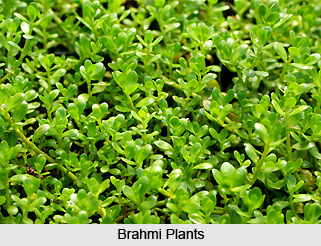 Brahmi is a diffusely branched, creeping herb which is found commonly in wet or marshy habitats and along stream and river margins all over India at an altitude of about 1300 meters. The Botanical name of this herb is Bacopa monnieri (L.) Pennell. Some of the other names by which Brahmi is known in different languages in India are Adhabirni, Dhopchamni, Brahmisak and Jalanimba in Bengali, Kadaviluni in Gujarati, Neer Brahmi and Nirubrahmi in Kannada, Neerbrahmi in Marathi, Brami, Nirbrahmi and Nirpirimi in Tamil, Jalanim and Nirabrahmi in Urdu language, Barambhi and Safedchanmi in Hindi, Nirubrahmi, Brahmi and Nirbrahmi in Malayalam, Brahmi and Nira-Brahmi in Sanskrit and Sarnbranichettu in Telugu.
Brahmi is a diffusely branched, creeping herb which is found commonly in wet or marshy habitats and along stream and river margins all over India at an altitude of about 1300 meters. The Botanical name of this herb is Bacopa monnieri (L.) Pennell. Some of the other names by which Brahmi is known in different languages in India are Adhabirni, Dhopchamni, Brahmisak and Jalanimba in Bengali, Kadaviluni in Gujarati, Neer Brahmi and Nirubrahmi in Kannada, Neerbrahmi in Marathi, Brami, Nirbrahmi and Nirpirimi in Tamil, Jalanim and Nirabrahmi in Urdu language, Barambhi and Safedchanmi in Hindi, Nirubrahmi, Brahmi and Nirbrahmi in Malayalam, Brahmi and Nira-Brahmi in Sanskrit and Sarnbranichettu in Telugu.
Brahmi is a creeping, diffusely branched and succulent herb. Its stems are obtuse-angular, 10 to 30 centimetres long and rooted at the nodes. There are numerous ascending branches. Leaves of this plant are sessile or short-petioled, obovate-oblong or decussate, 0.6 to 2.5 centimetres long and 0.2 to 1 centimetres wide, rather fleshy, dotted with black specks. Flowers of Brahmi are white to pale blue or violet in colour, and are solitary and borne in leaf axils on slender pedicels about 0.6 to 3.2 centimetres long. The calyx is glabrous, divided to the base, sepals c. 6 mm long, ovate or lanceolate, acute; corolla is 8 millimetres long, tube broadly campanulate, lobes nearly equal, rounded, with shining dots when fresh. Fruits (capsules) are 5 millimetres long, ovoid, acute, included in the persistent calyx and the seeds c. 0.85 millimetres long, oblong, striate and pale. Flowers and fruits are available in this plant throughout the year.
The entire plant is the source of the Ayurvedic drug Brahmi, an important ingredient of several Ayurvedic preparations like Brahmighritam (used for treating hysteria and epilepsy), Sarasvataristam, Brahmitailam, Brahmirasayanam and Misrakasneham. It is considered astringent, diuretic, laxative and a tonic for the nerves and heart, and is used in Ayurveda to improve memory and intelligence, and to treat anemia, dermatosis, diabetes, dropsy, cough, fever, anorexia, Dyspepsia or Agnimandya, arthritis, emaciation and insanity. In other traditional Indian systems of medicine it is used in treating hoarseness, anxiety neurosis, asthma, insanity, cough, dropsy, epilepsy, fever, Dyspepsia, anorexia and emaciation, and as a potent nerve tonic, diuretic and cardiotonic. The juice of the leaves of this medicinal plant of India is used in the treatment of bronchitis and diarrhoea in children and a paste of the leaves is applied to treat arthritis. Among the tribal inhabitants of Maharashtra, five leaves eaten daily for a month are believed to improve the speech of stutterers. The boiled leaves are applied to the abdomen to provide relief from postnatal pains by Bhil women in Rajasthan. The warmed leaves are also used by the Bhils as a poultice to relieve swellings following beatings.



















